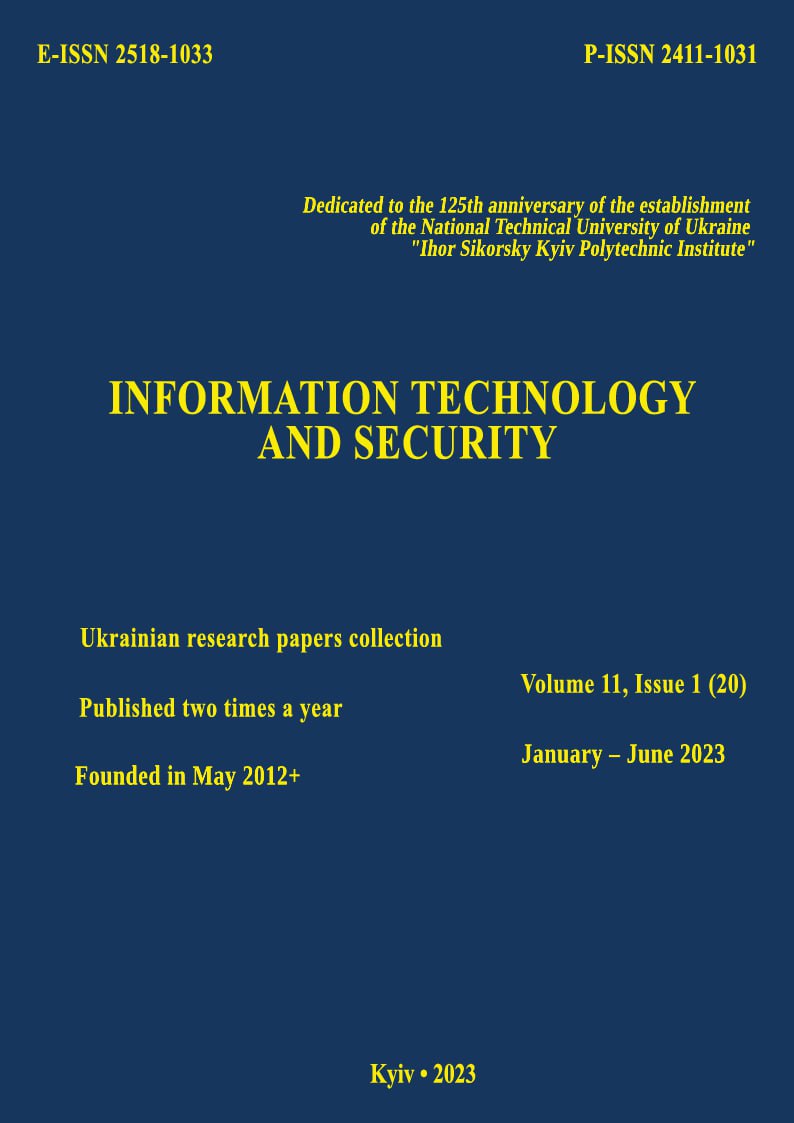Analysis of functional safety of electronic communication system equipment
DOI:
https://doi.org/10.20535/2411-1031.2023.11.1.283816Keywords:
functional safety, reliability, failures and rejections of software, equipment of electronic communication networksAbstract
Today, the equipment of electronic communication networks (EECN) consists of two interconnected components. The first is hardware, the second is software, the normal functioning of each of which depends on the functioning of the network in general. One of the main concepts characterizing the network's ability to perform tasks as intended is functional safety (FS). This concept is similar to the concept of reliability, but differs mainly in that in the context of reliability, all possible failure situations are considered, and when considering FS, only those that lead to the failure of the certain system functioning. Failures are divided into four categories: detected safe and dangerous, undetected safe and dangerous. From the point of view of FS, only undetected dangerous ones are considered and constitute threats. According to the number of dangerous undetected failures, there are four levels of security completeness. The article also considers the main international standards, which provide definitions and quantitative characteristics of the main parameters of FS. So, the main parameters of FS include the system availability ratio, the average time to failure, and the probability of a dangerous undetected failure. At the same time, the mathematical apparatus of reliability theory can be applied in the analysis of FS. At the same time, the hardware component of EECN is quite widely researched, and the software component needs further study. Also, the FS of the software component is affected by a number of factors, both external and internal. The further task consists in the formation of methods and measures aimed at eliminating or reducing the impact of influencing factors. Also, since various types of software, mainly system software, are widely used in EECN, it is necessary to focus further research on it.
References
G. J. Myers. Software reliability: principles and practices. New York, USA:Wiley, 1976.
V. B. Mendiratta, “Reliability Analysis in Telecommunications”, Notices of the American Mathematical Society, vol. 67, no. 6, 2020, doi: http://doi.org/10.1090/noti2095.
M. Sliwinski, E. Piesik, and J. Piesik, “Integrated functional safety and cyber security analysis”, IFAC-PapersOnLine, vol. 51, no. 24, pp. 1263-1270, 2018, doi: https://doi.org/10.1016/j.ifacol.2018.09.572.
G. M. Hulak, “The method of assessing the functional safety of information technologies for the creation of guarantee-capable automated systems”, Cyber security: education, science, technology, no. 3 (7), 2020, doi: https://doi.org/10.28925/2663-4023.2020.7.153164.
S. Kumari, R. Kumar, S. Kadry, S. Namasudra, and D. Taniar, “Maintainable stochastic communication network reliability within tolerable packet error rate”, Computer Communications, vol. 178, no. 1, pp. 166-168, 2021, doi: https://doi.org/10.1016/j.comcom.2021.07.023.
C. Rajasimha, R. Arjun, and G. Chandrashekhar, “Supplemental FMEA for monitoring and system response of electronic power steering control system functional safety”, SAE Technical Paper, 2022, doi: https://doi.org/10.4271/2022-28-0404.
V. Agrawal, B. Achuthan, A. Ansari, and V. Tiwari, “Threat / hazard analysis and risk assessment: a framework to align the functional safety and security process in automotive domain”, SAE Int. J. Transp. Cyber. & Privacy, vol. 4, no. 2, 2021, doi: https://doi.org/10.4271/2021-01-0148.
G. Peserico, A. Morato, F. Tramarin, and S. Vitturi, “Functional safety networks and protocols in the industrial internet of things era”, Sensors, vol. 21, no. 18, 2021, doi: https://doi.org/10.3390/s21186073.
IEC 61508-1:2010 Functional safety of electrical/electronic/programmable electronic safety-related systems – Part 1: General requirements. [Online]. Available: https://webstore.iec.ch/publication/5515. Accessed on: Feb. 19, 2023.
E. Babeshko, O. Ilyashenko, and V. Kharchenko, Functional safety of industrial systems Standard IEC 61508, Kyiv, Ukraine, 2019. [Online]. Available: https://tk185.appau.org.ua/whitepapers/aCampus-whitepaper-IEC-61508+++.pdf. Accessed on: Jan. 11, 2023.
IEC 60812:2006 Analysis techniques for system reliability – Procedure for failure mode and effects analysis (FMEA). [Online]. Available: https://webstore.iec.ch/publication/3571. Accessed on: Jan. 05, 2023.
Downloads
Published
How to Cite
Issue
Section
License
Copyright (c) 2023 Collection "Information Technology and Security"

This work is licensed under a Creative Commons Attribution 4.0 International License.
The authors that are published in this collection, agree to the following terms:
- The authors reserve the right to authorship of their work and pass the collection right of first publication this work is licensed under the Creative Commons Attribution License, which allows others to freely distribute the published work with the obligatory reference to the authors of the original work and the first publication of the work in this collection.
- The authors have the right to conclude an agreement on exclusive distribution of the work in the form in which it was published this anthology (for example, to place the work in a digital repository institution or to publish in the structure of the monograph), provided that references to the first publication of the work in this collection.
- Policy of the journal allows and encourages the placement of authors on the Internet (for example, in storage facilities or on personal web sites) the manuscript of the work, prior to the submission of the manuscript to the editor, and during its editorial processing, as it contributes to productive scientific discussion and positive effect on the efficiency and dynamics of citations of published work (see The Effect of Open Access).

